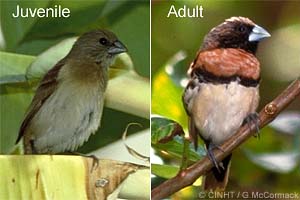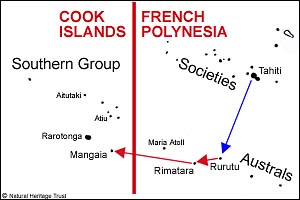Cook Islands Natural Heritage Articles
New Bird on Mangaia Identified
In the CI News (13 May) Sue Ngatokorua described a new bird on Mangaia, and the author suggested it might be a Chestnut-breasted Mannikin. In late May Peter Ngatokorua, who provided the original information for the news article, took Ian Karika and the author to see the birds in Vaitate swamp, and they were confirmed as Chestnut-breasted Mannikins. Groups of up to 30 were seen, and the population might be near 100.
Peter and others had concluded  that the bird arrived naturally, because arrival of any cagebird would have sent the inevitable buzz-of-curiosity throughout the Mangaian community. To honour the birds' great flight to Mangaia, Peter had suggested it be called Toa Kere-ā-Rangi, literally "mighty warrior of Rangi". While other Vaitate planters suggest it should be named Pātiki-‘Enua-ō-Rangi, an alternate name for Vaitate district, where it was first seen in 1999.
that the bird arrived naturally, because arrival of any cagebird would have sent the inevitable buzz-of-curiosity throughout the Mangaian community. To honour the birds' great flight to Mangaia, Peter had suggested it be called Toa Kere-ā-Rangi, literally "mighty warrior of Rangi". While other Vaitate planters suggest it should be named Pātiki-‘Enua-ō-Rangi, an alternate name for Vaitate district, where it was first seen in 1999.
Its history in Polynesia
The Chestnut-breasted Mannikin is a native bird of coastal northern and eastern Australia, southward to around Sydney. As a cagebird it was introduced to Tahiti in the late 1800s, where it  escaped and naturalised, and gradually spread to a few other islands in the Society Group. The mannikin was not seen on Rimatara during the bird survey by the Natural Heritage Trust in 1992, while during the June 2000 expedition with WWF they were seen several times feeding in small flocks along the sides of roads. In 2000, people on Rimatara said that the mannikin had arrived naturally in the mid-1990s from Rurutu, where they thought it had been introduced from Tahiti – date unknown.
escaped and naturalised, and gradually spread to a few other islands in the Society Group. The mannikin was not seen on Rimatara during the bird survey by the Natural Heritage Trust in 1992, while during the June 2000 expedition with WWF they were seen several times feeding in small flocks along the sides of roads. In 2000, people on Rimatara said that the mannikin had arrived naturally in the mid-1990s from Rurutu, where they thought it had been introduced from Tahiti – date unknown.
The mannikin is not wild on Rarotonga or any other island in the Southern Group. It is therefore most likely that the original Mangaia mannikins flew from Rimatara (530km) or from Rurutu (680km). Such an event might have been triggered and aided by the high winds of a large storm, and Rimatara and Mangaia may have got their stragglers or "mighty warriors" in the same event. This species is not recorded as a cagebird on Rarotonga, and there are no cagebirds on Mangaia, which makes it extremely unlikely that they were imported to Mangaia unnoticed.
Native or Introduced?
In the Cook Islands Biodiversity Database plants and animals are classified according to how they arrived as: Native (or Indigenous), for species arriving without human assistance; and Introduced for those arriving with the intentional or accidental assistance of people. Is the Chestnut-breasted Mannikin native or introduced on Mangaia? Considering that it is a native of Australia and that it was introduced to Tahiti as a cagebird it is an introduced bird of French Polynesia. And despite its magnificent flight from Rimatara or Rurutu to Mangaia, it should still be classified as an introduced bird.
Harmful or not?
Introduced plants and animals are also known as alien species, and those that harm local biodiversity are known as invasive alien species. Is the Chestnut-breasted Mannikin an invasive alien species, which should be eradicated?
The mannikin is the only bird on Mangaia feeding on grass seeds and Giant Bulrush ( Raupo ) seeds, and it is therefore not competing against native birds for food. The Cook Islands Reed-warber ( Kereārako ), which is often seen near and among the mannikins, is feeding on insects. There has been no reported die-off of native birds on Rimatara or Mangaia, which means the mannikin is not spreading any virulent bird disease that would be harmful to our native birds.
It is concluded that the Chestnut-breasted Mannikin is doing no particular harm, and that it is a welcome, attractive, and interesting addition to the biodiversity of Mangaia. It is likely that it will eventually fly the 250km to Rarotonga.
Description
The Chestnut-breasted Mannikin (Lonchura castaneothorax) is a small, reddish-brown finch with a black face, and a chestnut breast separated by a black line from a white belly. It is only 11cm long. Adult males and females are very similar, although the male has brighter colours. Only the male gives the high-pitched tit-tit-tit call. The young are mainly dull brown and grey.
Submitted to Cook Islands News, June 2006
First article:
Mangaia School/CINews (2006) New bird on Mangaia?, CI News 13 May 2006.
About Gerald McCormack
 Gerald McCormack has worked for the Cook Islands Government since 1980. In 1990 he became the director and researcher for the Cook Islands Natural Heritage Project - a Trust since 1999.
He is the lead developer of the Biodiversity Database, which is based on information from local and overseas experts, fieldwork and library research. He is an accomplished photographer.
Gerald McCormack has worked for the Cook Islands Government since 1980. In 1990 he became the director and researcher for the Cook Islands Natural Heritage Project - a Trust since 1999.
He is the lead developer of the Biodiversity Database, which is based on information from local and overseas experts, fieldwork and library research. He is an accomplished photographer.
Citation Information
McCormack, Gerald (2006) New Bird on Mangaia Identified. Cook Islands Natural Heritage Trust, Rarotonga. Online at http://cookislands.bishopmuseum.org. ![]()
Please refer to our use policy
